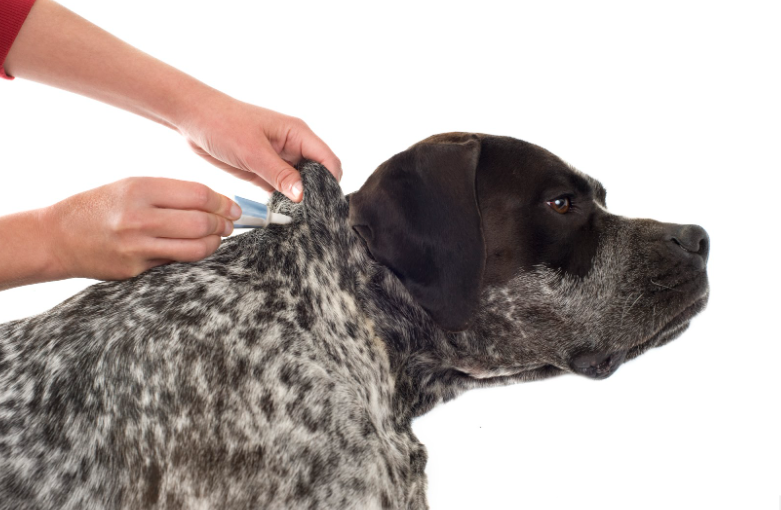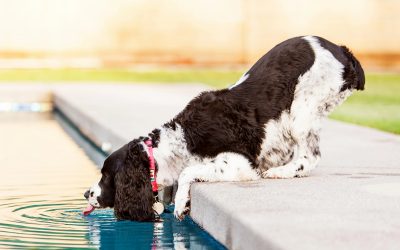As a pet owner, you probably know that dogs scratch themselves. The image of a dog scratching behind its ears or under its collar is more common than with any other pet. The “itch” epidemic — dogs scratching themselves to the point of distraction due to flea bites or other issues — can be a common problem for dog owners.
Flea bites on dogs are more than a nuisance. A flea infestation can lead to potential health risks for your pup, ranging from infections when dogs scratch too much and break the skin to serious conditions like flea-borne typhus.
At Halo, your dog’s comfort is our priority. We consider it when creating our wireless dog fence products as well as our site content. That’s why we’ve provided a guide to flea bite relief and prevention below.
How to Identify Flea Bites on Dogs
The first step to addressing flea bites on dogs is to understand whether this is the issue with your dog’s skin. Dogs might also scratch due to issues like dry skin, allergies, hormonal imbalances, parasites or even boredom. Correctly identifying the reason for the behavior helps you resolve the issue faster.
Flea bites look like small red bumps on your dog’s skin. If your dog is exhibiting signs of itching, including scratching, biting or chewing its skin, try to get a look at the area. Raised red bumps are a pretty good indication that flea treatment might be in order. Scabs or hair loss where a dog has scratched itself raw can also indicate flea bites, but it might be helpful in this case to consult a vet to rule out other issues, such as allergies or skin conditions.
Of course, if you can see the fleas on your dog, that’s another good indication that flea treatments might solve the issue. Fleas like to hide in areas with thicker fur or snug spots like joints near the legs and shoulders. You should also check in and around ears and under your dog’s collar if looking for evidence of fleas.
Scratch That Itch: Treating Flea Bites on Dogs
If you find flea bites and adult fleas on your dog, you’ll need to take action to address the issue. If your dog is in good health and there are no worries about infections or a lot of broken skin, you can try soothing relief via home remedies and over-the-counter options first. Consider using over-the-counter flea shampoo to clean your dog and kill or deter fleas. Follow that up with a flea comb to remove flea eggs that might be in your dog’s hair — this can reduce the chance of reinfestations later.
Some home remedies that might help deter fleas include applying coconut oil to your dog’s coat or bathing your pup in apple cider vinegar. When leveraging home remedies, do your research and consider asking your vet if the action is safe for your dog. For example, while some essential oils might help deter fleas, they aren’t all safe for your dog.
While flea bites can often be treated with over-the-counter topical medications and other methods at home, there are times when you should get a vet involved. If your dog shows signs of serious allergic reactions to flea medication or other insect bites, including swelling or problems breathing, or you’re concerned about secondary infections due to open wounds from scratching, contact your vet.
How to Prevent Flea Infestation

Whether OTC remedies or prescribed flea medications get rid of the problem, your work as a pet owner isn’t over. It’s important to take a multipronged approach to both flea and tick prevention. The good news is that a lot of what you do to remove fleas and prevent them in the future also works for tick prevention.
Begin by treating your dog, home and yard. Research flea collars that keep live fleas off your dog, flea treatments you apply periodically that kill fleas or oral medications that work to prevent fleas. Look for options that are also tick-preventive, especially if you live in an area where ticks are prevalent. Talk to your vet about options, as they may be able to prescribe or recommend something that works well for your pup.
If you spot fleas in your home that aren’t on your dog, you may have an active flea problem. Diatomaceous earth or baking soda and salt mixtures can be used as natural flea repellents around the perimeter of your home. If the infestation is severe, call in pest control professionals to treat your home and yard.
Once you rid your dog and home of fleas, work to maintain a flea-free environment in the future. Invest in regular brushing and grooming for your dog. You can buy tools such as pet combs and baths to do this at home or take your pup to a doggy spa for regular grooming. A clean, well-groomed dog appropriately treated for fleas is much less likely to develop a serious flea issue.
Keeping your home clean and free of clutter and maintaining your yard can also help prevent flea bites and infestations. You might also plant naturally flea-repelling plants like chamomile, lavender or lemongrass. Be vigilant if your pup likes to chew plants and grass in your yard, however, as plants like lemongrass can be dangerous for dogs in large quantities. In this case, opt for plants that are safer for your dog.
Beyond the Itch: Long-Term Health Implications of Flea Bites
In some cases, flea bites can lead to issues that go behind irritated skin and dog scratches. A common issue is flea allergy dermatitis (FAD). This common allergic reaction occurs when a dog’s immune system is hypersensitive to flea bites, causing an overreaction to the bite and leading to symptoms such as loss of fur, inflammation, broken or weeping skin and agitation.
Fleas can also carry more concerning problems, including tiny parasites and tapeworms that they transmit to dogs via bites. Signs that fleas may have passed on these types of issues can include changes in your dog’s appetite, weight loss with no other explanation, worms or blood in your dog’s stool or swelling in your dog’s body, especially around the belly.
Preventive measures such as regular checkups and flea control are critical to reducing the chances your dog might deal with these issues or heading them off early if they do occur.
Flea-Free Fun in the Sun for Your Pup
Your dog’s fur naturally picks up things as you adventure and play outdoors with your pet. Those things, ranging from twigs and dirt to fleas, may get carried into your home and even impact your other pets. Checking your dog’s skin carefully for evidence of fleas and ticks and engaging in flea prevention can help ensure your pup enjoys fun in the sun without paying for it later with itching skin.
You can also support outdoor fun for your dog while reducing the risks of fleas, ticks and other problems by protecting your pet with Halo Collar. Our solutions provide GPS tracking and virtual fences, letting you set customized ranges for your pup. Halo Collar helps promote overall health and safety for dogs and peace of mind for dog owners. For example, you can use our wireless dog fence to keep your pup away from unkept areas of a property or nearby fields with high grass where fleas and ticks are likely to lurk.
To learn more about how Halo Collar can help you promote health and safety for your active dog, check out our blog or shop for Halo Collar products.










